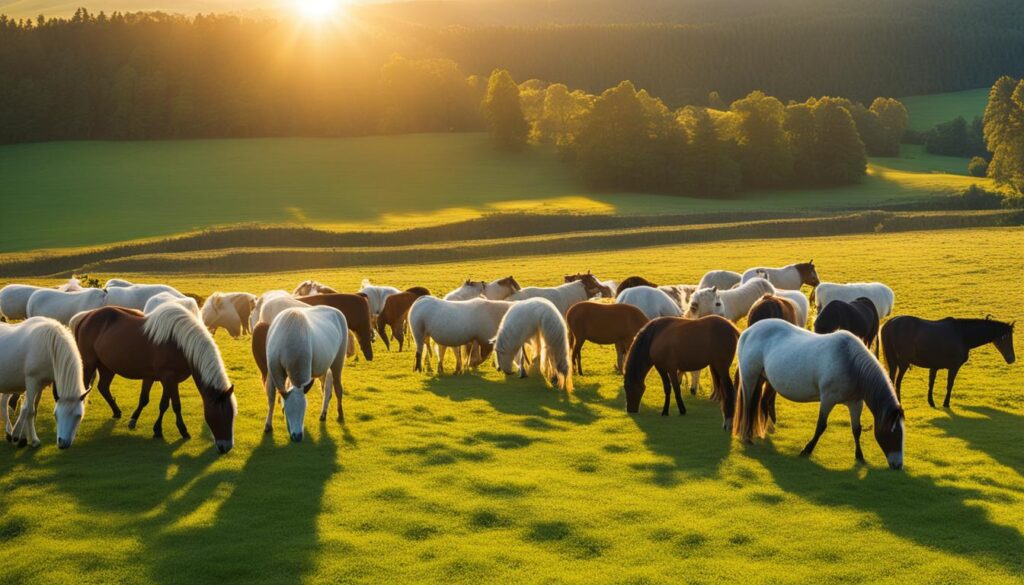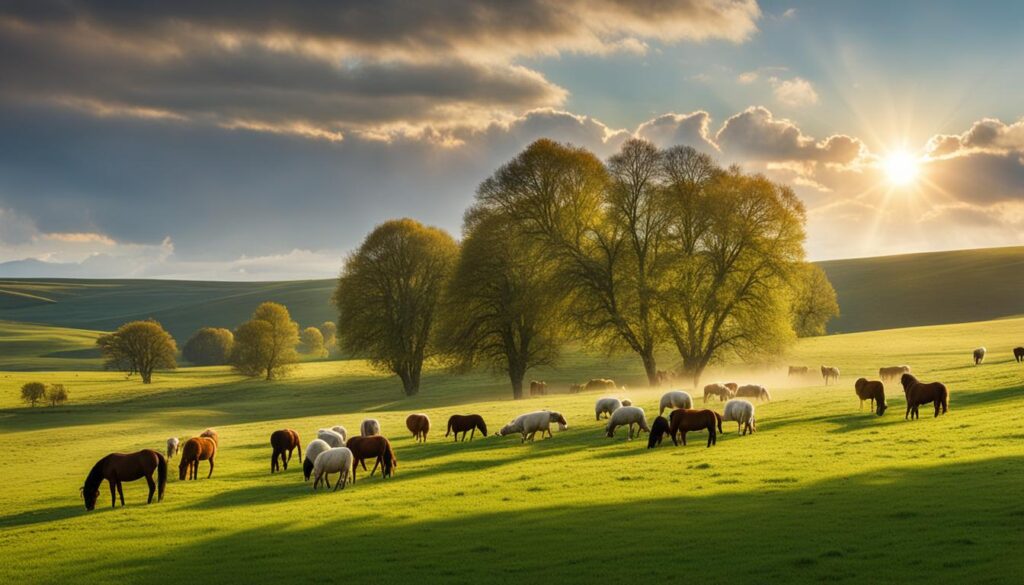As a hobby farmer, I’ve become increasingly invested in the harmony of nature and the art of land stewardship. There’s something deeply satisfying about watching my horses and sheep grazing together, each animal complementing the other’s presence while embodying a time-honored practice in synergistic pasture management. It’s a method that merges respect for tradition with my commitment to sustainable farming practices. My experiences have taught me the value of leveraging each species’ grazing habits to create a sustainable, productive ecosystem right in my backyard.
In this journey, I’ve embraced the mutual benefits that arise when these two animals share the same pasture. The horses and sheep not only enjoy a varied diet but also contribute to the health of the land, helping to cultivate a more resilient environment naturally. It’s a poignant reminder that sometimes, the old ways—rooted in symbiotic relationships and ecological balance—can offer powerful solutions in our modern quest for sustainability.
Key Takeaways
- Multispecies grazing is an ancient farming strategy that promotes sustainable farming practices.
- Horses and sheep grazing together can lead to a more nutritious and well-managed pasture.
- The combination of different grazing behaviors enhances soil health and reduces the need for chemical interventions.
- Regular pasture management is critical when practicing synergistic pasture management.
- Adopting this approach reflects a commitment to environmentally friendly farming methods.
Understanding Multispecies Grazing Benefits
When I delve into the practice of multispecies grazing, I’m reminded of its time-honored roots, a tradition that fostered pastoral cohabitation long before the term “sustainability” became a beacon for modern agriculture. Embracing this method once again, I see it as an innovative step towards integrating sustainable pasture strategies into my own farming endeavors.
Considering the uniqueness of each grazing animal empowers us to understand the overarching benefits that these practices yield, from ecological enrichment to financial savings. Let me walk you through some of these compelling advantages.
The Historical Context of Pasture Cohabitation
In history’s pages, the union between different livestock species on the same pasture unfolds as a narrative of survival and efficiency. This traditional approach is woven into the fabric of various cultures, maximizing land use efficiency and sustaining pastoral communities. As we refocus the lens on the present, it’s evident that cross-grazing benefits are as relevant now as they were centuries ago.
Environmental and Economic Advantages
The multitude of benefits that arise from the co-grazing of horses, sheep, and other livestock is profound. The environmental impact is two-fold: a significant reduction in the need for chemical interventions and an increase in biodiversity. Economically, it boils down to an effective reduction in feed costs and a diminished reliance on machinery for land maintenance. These advantages make the concept not just romantically idyllic but pragmatically sound.
Improving Pasture Health Through Diverse Grazing Habits
Horses, with their preference for succulent grasses, maintain these pastures at a palatable length while sheep complement this by consuming the more fibrous plants—each species naturally keeping the land in balance. It’s this very synergy that elevates multispecies grazing from a simple idea to a strategic pastoral practice.
| Sustainable Strategy | Environmental Benefit | Economic Benefit |
|---|---|---|
| Reduced need for herbicides | Preservation of native flora and fauna | Cost savings on chemical treatments |
| Minimized machinery use | Lower carbon footprint | Decrease in fuel and repair expenses |
| Optimization of forage | Enhanced soil health and structure | Less reliance on supplemental feeds |
As we continue to explore and apply these principles, it’s clear that the revival of multispecies grazing is not merely a nod to tradition, but a stride towards a more resilient and self-sustaining future in agriculture.
How Horses and Sheep Grazing Together Enhances Pasture Management
As an advocate for ecological livestock keeping, I’ve witnessed firsthand how integrated grazing systems pave the way for more sustainable and productive pasture management. By allowing horses and sheep to graze in concert, my land has become a haven for forage optimization, heralding an era of more efficient land use.

The hidden harmony in the grazing patterns of these animals is simple yet profound. Where my horses graze, they nibble the grasses down to a preferred length, inherently practicing a form of grazing strategies themselves. However, it’s the sheep that follow, feasting on the taller, less desirable plants left behind by their equine comrades, that truly demonstrate nature’s balanced approach to forage optimization.
Let’s break it down with some visual representation:
| Animal | Type of Forage Consumed | Benefit to Pasture |
|---|---|---|
| Horses | Short, tender grasses | Prevent overgrowth, maintain sward density |
| Sheep | Taller grasses and weeds | Reduce weed population, promote plant diversity |
This symbiotic relationship between horse and sheep grazing leads to a diverse pasture ecosystem, which not only supports a wide array of wildlife but also prevents soil erosion—a cornerstone of ecological livestock keeping. With such a system, I find my involvement in managing the land reduces, as nature takes on a more significant role in its own upkeep.
By embracing these practices, we as farmers and land stewards contribute to an agricultural legacy that marries productivity with respect for the earth—a true embodiment of integrated grazing systems at work.
Addressing Parasite Control Naturally with Mixed Grazing
As a hobby farmer, I’ve seen firsthand the remarkable benefits of allowing horses and sheep to graze together. It’s not just about efficient land use; it’s a strategic move in the ever-important battle against parasites. This symbiosis between species creates a unified front in natural parasite management, something I’ve become increasingly passionate about.
Integrating these animals on the same pasture plays a significant role in interrupting the lifecycle of host-specific parasites, which are adapted to survive in only one species. It’s fascinating to observe how cross-grazing for worm control naturally unfolds, reducing the reliance on pharmaceutical interventions—here’s a deeper dive into how this concept works practically.
Cross-Species Grazing and Parasite Lifecycle Interruption
The mechanics underlying this process are elegant in their simplicity. A worm that might pose a threat to my horses will find no haven in the digestive system of my sheep. Consequently, by the time the horses graze upon those areas again, the parasites’ window of opportunity has closed, effectively breaking their lifecycle without the need for additional chemicals.
The Host-Specificity of Parasites in Horses and Livestock
This disrupts the insidious cycle where parasites might otherwise gain a foothold. Horses and sheep host different parasites; this host-specificity offers a natural form of worm control that is both species-appropriate and gentle on the environment.
- Natural Parasite Management: Utilizes the natural behaviors of different species to manage parasite loads without chemicals.
- Host-Specific Parasites: A parasite that can infect one species does not usually pose a risk to a different species when grazing together.
- Cross-Grazing for Worm Control: Alternating different livestock on the same pasture to break the parasites’ lifecycle with species diversity.
| Parasite | Primary Host | Interrupted by Species | Management Benefit |
|---|---|---|---|
| Strongyles | Horses | Sheep | Reduced need for deworming |
| Nematodirus | Sheep | Horses | Lower parasite infection rate |
| Ascarids | Horses | Sheep | Enhanced pasture health |
The table highlights the effective disruption of parasitic lifecycles through cross-species grazing, showcasing a practical and harmonious approach to natural parasite management. This approach not only sustains our pastoral landscapes but also ushers us toward a more holistic way of farming that respects the ties between animal health and the land we steward.
Considerations for Harmonious Pasture Sharing
As we delve deeper into the art of pasture sharing between species, understanding the dynamics of cohabitation becomes essential. The process of blending horses and sheep in a shared environment presents unique challenges. Dominance behavior, territorial disputes, and resource sharing all play a role in the delicate balance of a mixed-species habitat. Prioritizing the wellbeing of these animals requires a nuanced approach to management, emphasizing the importance of safe grazing infrastructure and proactive disease management.
Behavioral Dynamics Between Horses, Sheep, and Other Livestock
After spending countless hours observing my own mixed herds, I’ve come to realize that the cohabitation challenges one faces can arise from the most basic instincts of these animals. Horses, being naturally dominant animals, may not always share spaces gracefully with sheep, which necessitates thoughtful integration strategies. Ensuring that sheep have access to escape areas, and that both species have ample space, can help mitigate stress and potential conflict.

Infrastructure Adaptation for Safe Co-Grazing Environments
To foster a secure habitat for these animals, adjustments to the physical infrastructure of the pasture are often required. Safe grazing infrastructure plays a pivotal role in peaceable cohabitation. This means fences must be robust and appropriately sized to contain both species, and shelters should be accessible to all. Safe grazing spaces not only prevent escape but also minimize the chances of injury arising from potential altercations.
Disease Prevention and Management in a Multi-Species Setting
Disease management in mixed herds is the cornerstone of a successful multi-species grazing system. While many diseases are host-specific, proactive health checks and quarantine measures for new or ill animals help prevent the spread of transmissible conditions like ringworm or leptospirosis. I’ve found that regular veterinary check-ups, vaccinations, and a keen eye for any signs of illness are indispensable practices for anyone invested in the health of their herd.
Ultimately, integrating horses and sheep on the same pasture is a symbiotic strategy that, with the right management, can yield numerous benefits. By understanding and addressing the cohabitation challenges, ensuring safe grazing infrastructure, and diligently managing diseases, hobby farmers like myself can enjoy the rewards of sustainable farming with healthy, happy animals.
Implementing Effective Grazing Systems for Horses and Sheep Together
As I wander through my bustling pastures, I’m often struck by the harmonious interplay between my horses and sheep. This synergy didn’t arise by chance; it’s the result of implementing effective rotational grazing techniques—a system that has revolutionized the way I manage my land and the health of my animals. Through this article, I hope to share how such systems can be beneficial, and how with a little foresight and planning, they can be successfully applied to your agricultural endeavors too.
Rotational Grazing and Its Impact on Forage Utilization
My experience with rotational grazing began as an experiment. I segregated my pastures into smaller, manageable plots, allowing my horses and sheep to graze one section before moving to the next. This method gave sections time to recover, promoting regrowth of high-quality forage. My pastures have never been healthier, and the animals have plentiful, nutritious feed. It’s a technique that speaks for itself—rotational grazing conserves resources while ensuring that every blade of grass is used to its full potential.
Stocking Rates and Pasture Recovery Strategies
Finding the right balance with pasture stocking rates proved to be crucial. By calculating the appropriate number of animals per pasture based on the land’s yield and their dietary needs, I’ve prevented overgrazing, which can devastate land and leave it vulnerable to erosion and weed invasion. In the off-season, I focus on forage restoration methods to enhance soil quality and encourage robust grass growth for the upcoming grazing cycle. It’s a persistent balance of giving and take, necessitating careful observation and a willingness to adapt to the land’s and animals’ needs.

